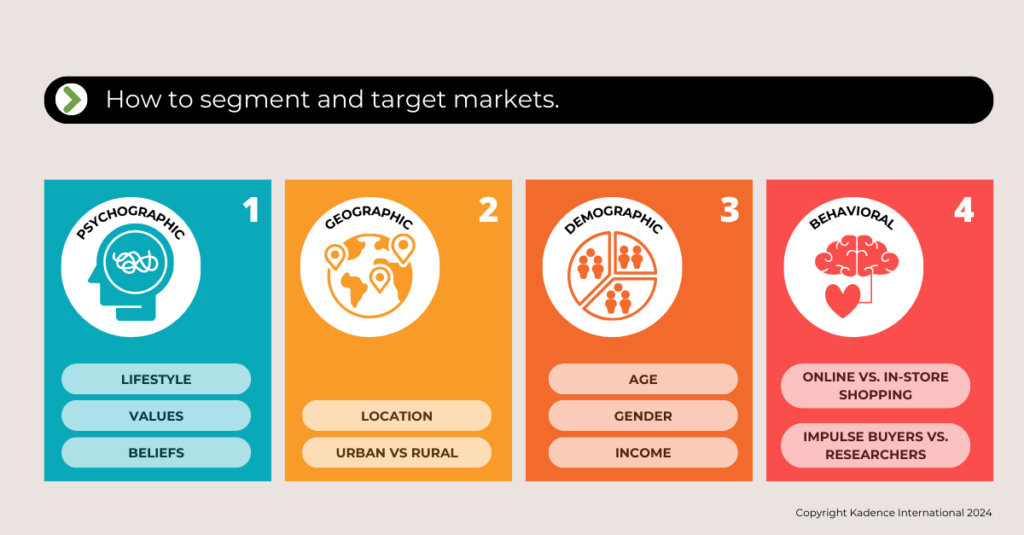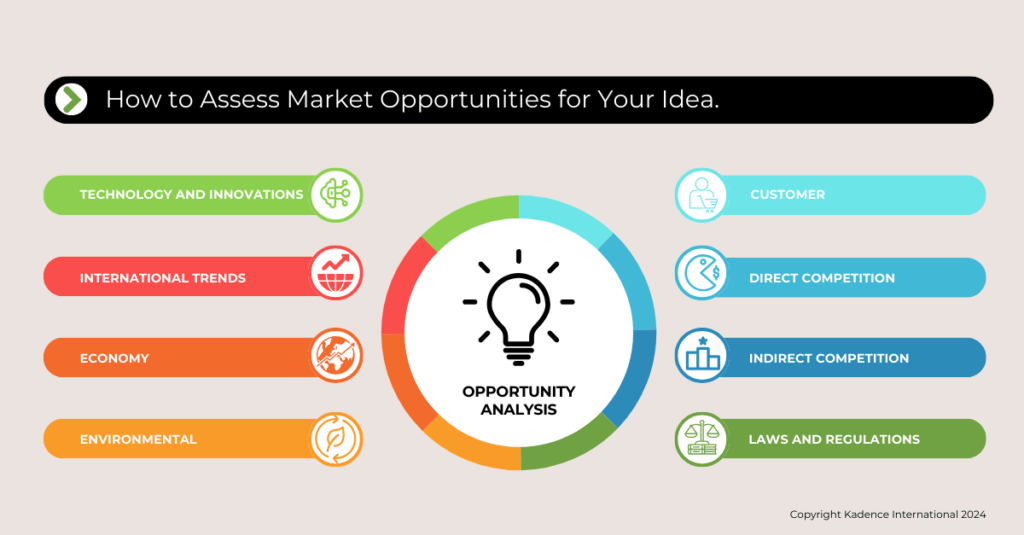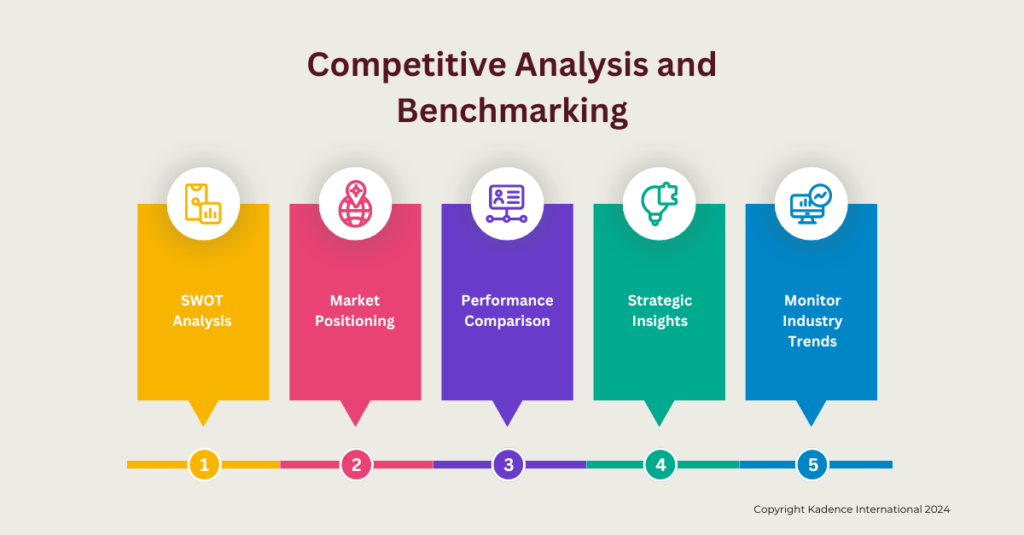Many groundbreaking business ideas are said to have originated on the back of a napkin or during a moment of clarity in the shower. Think about how Airbnb started with two friends renting out air mattresses in their apartment or how a trip to Italy inspired Starbucks. These stories are intriguing, but the true challenge lies in transforming these initial sparks into viable market opportunities.
Definition of Market Opportunities
Market opportunities refer to favourable conditions within a market environment that enables a company to capitalise on customer needs and desires. These opportunities could arise from unmet consumer demands, emerging trends, technological advancements, or shifts in regulatory landscapes. Identifying and seizing market opportunities is at the heart of business growth and innovation.
Importance of Market Research

Market research plays a pivotal role in uncovering and understanding market opportunities. It systematically gathers, analyzes, and interprets data related to target markets, customers, competitors, and industry trends. This process provides critical insights that guide strategic decision-making, product development, and market positioning.
International Market Expansion
Expanding into international markets presents significant growth potential for brands. It allows companies to tap into new customer bases, access diverse talent pools, and mitigate risks associated with operating in a single market.
However, international expansion poses unique challenges, such as cultural differences, regulatory complexities, and market readiness considerations.
The following sections will explore how market research can help identify and leverage market opportunities, particularly within international expansion. By adopting a structured approach to market analysis, brands can navigate the complexities of global markets and position themselves for sustainable growth and success.
Understanding Market Research for Identifying Opportunities
Market research is the cornerstone for identifying and capitalising on market opportunities. It encompasses various activities to understand consumer behaviour, market dynamics, and competitive landscapes.
Types of Market Research
Market research can be broadly categorised into two main types:
Quantitative Research
Quantitative research quantifies market trends, preferences, and behaviours using numerical data and statistical analysis. This involves surveys, questionnaires, and data analytics to gather measurable insights. For example, conducting a survey to determine the percentage of consumers interested in a new product feature.
Qualitative Research
Qualitative research aims to uncover deeper insights into consumer perceptions, motivations, and preferences. It involves focus groups, interviews, and observational studies to gather subjective data. Qualitative research is valuable for understanding the ‘why’ behind consumer behaviours and uncovering unmet needs.
Market Segmentation
Market segmentation involves dividing a broad target market into smaller, more manageable segments based on shared characteristics or behaviours. This allows businesses to tailor their marketing strategies and offerings to specific customer groups. Segmentation criteria can include demographics (age, gender, income), psychographics (lifestyle, values), behavioural traits (usage patterns, brand loyalty), and geographic factors (location, climate).

Effective market segmentation enables brands to identify niche markets, personalise marketing messages, and develop products that resonate with specific customer segments. By leveraging quantitative and qualitative research methods, brands can comprehensively understand their target markets and uncover actionable insights to capitalise on market opportunities effectively.
Steps to Identify Market Opportunities
Identifying market opportunities requires a structured approach that involves thorough research and analysis. Here are key steps to effectively identify and capitalise on market opportunities:

Define Your Objectives
Begin by defining clear objectives and goals for market expansion. Determine what you aim to achieve through market research and identify specific metrics for success.
Clarify Goals for Market Expansion
Specify the desired outcomes of market expansion efforts, whether it is increasing market share, launching new products, entering new geographical regions, or diversifying customer segments.
Specify Target Markets
Identify the target markets where you intend to focus your efforts. Consider factors such as demographics, psychographics, geographic location, and behavioural traits of your ideal customers.
Conduct Preliminary Research
Initiate preliminary research to gather foundational insights about the market landscape. This could involve desk research using existing data sources, industry reports, and market studies.
Analyze Existing Data and Trends
Evaluate historical data and current market trends to identify patterns, opportunities, and potential gaps in the market. Look for emerging trends that could influence consumer behaviours and preferences.
Study Consumer Behavior
Understand consumer needs, motivations, and purchase behaviors through qualitative and quantitative research. This includes surveys, focus groups, interviews, and observational studies.
Market Segmentation
Segment the target market into distinct groups based on demographic (age, gender, income), psychographics (lifestyle, values), and behavioral (usage patterns, brand loyalty) factors. This segmentation helps in tailoring marketing strategies and product offerings.
- Demographic Segmentation: Divide the market based on age, gender, income, education, etc.
- Psychographic Segmentation: Group consumers based on lifestyle, personality traits, values, and interests.
- Behavioural Segmentation: Classify consumers based on usage patterns, brand loyalty, benefits sought, and purchasing behaviour.
Geographic Analysis
Assess geographic factors such as location, climate, population density, and cultural preferences that impact market dynamics and consumer behaviour.
Competitor Analysis
Identify key competitors operating in the target markets. Analyze their strategies, market positioning, strengths, weaknesses, and customer perceptions.

- Identify Key Players in Target Markets: Identify direct and indirect competitors, including market leaders and niche players.
- Analyze Competitor Strategies and Market Positioning: Understand how competitors differentiate themselves, as well as their pricing strategies, distribution channels, and branding tactics.
SWOT Analysis
Conduct a SWOT (Strengths, Weaknesses, Opportunities, Threats) analysis to assess internal capabilities and external market conditions.
- Assess Strengths, Weaknesses, Opportunities, and Threats: Identify internal strengths and weaknesses and external opportunities and threats in the market environment.
- Identify Competitive Advantages: Determine unique selling propositions (USPs) and competitive advantages that can be leveraged in the market.
Identify Emerging Trends
Monitor technological advancements, shifts in consumer preferences, and regulatory changes that could create new market opportunities.
- Technological Advancements: Explore how emerging technologies can disrupt existing markets and create new demand.
- Shifts in Consumer Preferences: Stay attuned to changing consumer behaviours, preferences, and expectations.
Assess Regulatory and Cultural Factors
Understand legal and regulatory frameworks governing the target markets and cultural sensitivities that influence consumer perceptions and buying decisions.
- Legal and Regulatory Frameworks: Comprehend laws related to product safety, labelling, import/export regulations, etc.
- Cultural Sensitivities and Adaptation: Customise marketing strategies and product offerings to align with the cultural norms and values of the target audience.
Exploring International Market Opportunities
Expanding into international markets offers tremendous growth potential but requires a thorough understanding of the foreign market landscape. Brands can unlock international market opportunities and establish a strong foothold in new territories by conducting thorough market research, assessing risks, and adapting strategies to local market conditions.
Strategic partnerships and cultural sensitivity play crucial roles in successful international expansion, allowing businesses to build trust and credibility with local consumers while mitigating risks associated with entering foreign markets.
Here’s how to navigate international market opportunities effectively:
Researching Foreign Markets
Before entering a new international market, conduct comprehensive research to gather insights into:
- Analyze Economic and Political Conditions
Assess the target country’s economic stability, GDP growth, inflation, and political stability. Economic and political conditions can significantly impact market dynamics and business operations.
- Evaluate Market Readiness and Accessibility
Determine the level of market readiness for your products or services in terms of infrastructure, distribution channels, and regulatory frameworks. Evaluate market accessibility in terms of trade barriers, import/export regulations, and logistical challenges.
- Assessing Market Demand
Understand the demand for your offerings in the target market by:- Identify Unmet Needs and Emerging Trends
Identify gaps in the market and emerging trends that align with your product or service offerings. Look for opportunities to introduce innovative solutions that address unmet consumer needs. - Consider Local Preferences and Buying Behaviors
Study consumer preferences, buying behaviours, and cultural influences that shape purchasing decisions. Tailor your products, pricing, and marketing strategies to resonate with local tastes and preferences.
- Identify Unmet Needs and Emerging Trends
Risk Assessment
Assess potential risks associated with entering the international market, including:
- Currency Fluctuations
Monitor exchange rate fluctuations and currency risks that impact pricing strategies and profit margins.
- Political Stability and Trade Policies
Evaluate political stability, trade agreements, tariffs, and trade policies affecting market entry and business operations.
- Cultural Adaptation and Localisation
Adapt your marketing communications, branding, and product offerings to suit cultural nuances and local customs. Consider:
- Language and Communication
Translate marketing materials and product information into the local language(s) to enhance customer engagement and understanding.
- Cultural Nuances in Marketing
Tailor marketing messages and campaigns to resonate with the target audience’s cultural values, beliefs, and traditions.
Partnerships and Alliances
Establish strategic partnerships and alliances to navigate the complexities of international markets:
- Identify Local Partnerships
Collaborate with local distributors, suppliers, or retailers who have a deep understanding of the local market landscape and consumer preferences.
- Utilise Distribution Networks
Leverage existing distribution networks and logistics partners to streamline market entry and ensure efficient supply chain management.
Success Stories of Brands Turning Ideas into Opportunities
These brand success stories highlight the significance of innovation, adaptation, and strategic partnerships in turning ideas into successful market opportunities and expanding internationally.
Airbnb: From Air Mattresses to Global Hospitality
Idea: In 2007, Brian Chesky and Joe Gebbia rented air mattresses in their San Francisco apartment to accommodate local conference attendees. This innovative idea evolved into Airbnb, a platform connecting travellers with unique accommodations worldwide.
Opportunity: Recognising the growing demand for authentic travel experiences and alternative accommodations, Airbnb disrupted the hospitality industry by leveraging the sharing economy.
Success Stories of Brands Expanding Internationally
Coca-Cola: Global Icon of Brand Expansion
Expansion Strategy: Coca-Cola’s journey from a local Atlanta beverage in 1886 to a global brand is a testament to strategic international expansion. By establishing bottling partnerships and adapting marketing campaigns to local cultures,
Coca-Cola penetrated diverse markets worldwide.
Opportunity: Coca-Cola capitalised on universal appeal, adapting flavours and branding to suit regional preferences while maintaining a global brand identity.
Lessons Learned and Best Practices
Starbucks: Cultivating a Global Coffee Culture
Lesson Learned: Starbucks’ successful international expansion emphasises the importance of localisation. By adapting menu offerings, store designs, and customer experiences to reflect local tastes and traditions, Starbucks created a sense of familiarity and acceptance in diverse markets.
Best Practice: Invest in market research to understand cultural nuances, consumer behaviours, and competitive landscapes before entering new markets. Build strategic partnerships with local suppliers and distributors to navigate regulatory complexities and ensure supply chain efficiency.
Amazon: E-commerce Innovation Across Borders
Lesson Learned: Relentless innovation and customer-centricity fuel Amazon’s global expansion. The company prioritises customer experience, offering localised websites, fast delivery options, and personalised recommendations tailored to each market.
Best Practice: Prioritise scalability and flexibility in operations. Amazon’s adaptable business model allows for rapid expansion into new geographies while optimising logistics and supply chain management.
Final Thoughts
Market conditions are dynamic and subject to change. Continual analysis and monitoring of market trends and consumer preferences are essential for staying ahead of the curve:
- Adapt to Emerging Trends: Regularly update market research to identify emerging trends, technological advancements, and shifts in consumer preferences.
- Stay Competitive: Analyze competitor strategies and market positioning to identify opportunities and refine business strategies accordingly.
Turning market research findings into actionable insights is key to successful market expansion:
- Strategic Decision-Making: Use market research insights to inform product development, pricing strategies, and marketing campaigns.
- Optimise Market Entry: Leverage data-driven insights to enter new markets confidently, understand local preferences, and adapt offerings accordingly.
Your idea, too, may begin as a simple concept sketched on a napkin or born out of a moment of inspiration.
Market research will take the idea to the market, turning it into a global success story. Companies can seize opportunities and expand their reach beyond borders by conducting a thorough analysis, understanding consumer needs, and adapting strategies to local markets.
Just as Airbnb started with air mattresses and Starbucks with a vision for a global coffee culture, your next business breakthrough could be discovered through diligent market research. Embrace the spirit of innovation, leverage actionable insights, and remember the journey from an idea on a napkin to a thriving international enterprise is within your grasp.
All you need to do is take that idea, conduct your market research, and embark on the path to realising your global ambitions. The next big success story could be yours. Let market research be your compass, guiding you toward unprecedented market opportunities and sustainable growth on a global scale.



 Senior Marketing Executive
Senior Marketing Executive Sales & Marketing
Sales & Marketing General Manager PR -Internal Communications & Government Affairs
General Manager PR -Internal Communications & Government Affairs Vital Strategies
Vital Strategies
 Customer Intelligence Director
Customer Intelligence Director